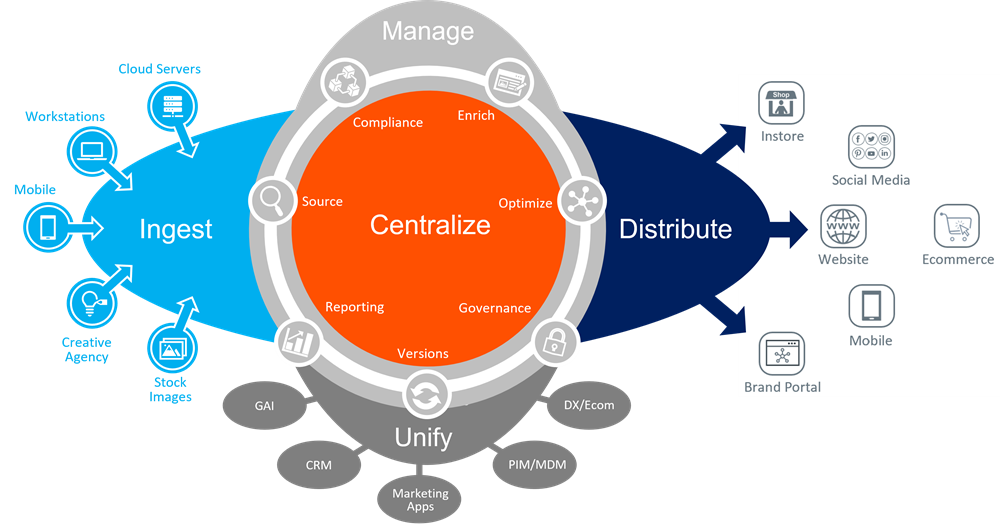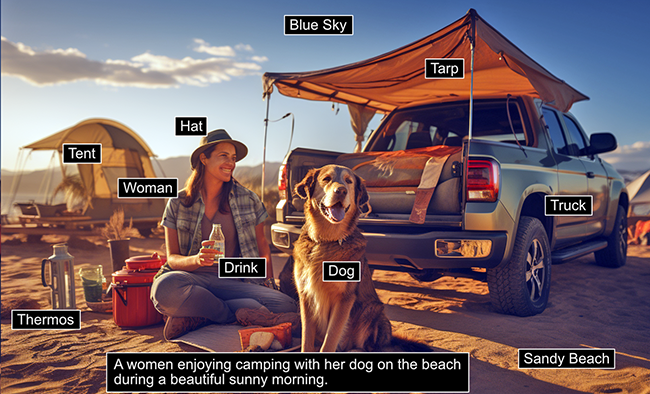Going Composable DX – Don't overlook DAM
In the rapidly evolving world of digital customer experience (DX), we are seeing brands increasingly ditch the rigid all-encompassing monolithic DX platforms (DXP). Instead, they are turning to the versatility and adaptability of composable DX technology stacks. These stacks are carefully composed of best-of-breed technologies tailored to a brand's unqiue business needs. By adopting this modular and flexible approach brands gain the ability to rapidly adapt and customize their digital customer experience solutions to keep pace with the ever-changing expectations of today's consumers.
Yet, amidst the ongoing discussions about composable DX, there exists a trio of technologies that are frequently overlooked. In this three-part article series, we will shed light on these overlooked technologies: Customer Data Platforms (CDP), Digital Asset Management (DAM), and advanced search and discovery systems (Intelligent Search). By incorporating these technologies into their composable DX stacks, brands will be able to deliver more effective customer experiences at scale and lay a solid foundation for future Generative DX capabilities.
In this first installment, we explore Digital Asset Management's (DAM) pivotal role in orchestrating highly effective digital customer engagement. As brands strive to connect with customers across multiple digital touchpoints, the efficient management and optimal utilization of digital assets is essential. The coming content explosion fueled by the demand for more immersive customer experiences and the speed of content development facilitated by Generative AI, is set to intensify this necessity. Consequently, we felt the time was right to take a fresh look into the role of the modern DAM as it related to digital experience and its importance as an integral component within brand's composable DX stack.
A DAM system provides a centralized source of brand-approved digital assets that are data enriched and optimized for specific channel usage.
Digital Asset Management (DAM) software has a long history, dating back to the early 1990s. DAM’s primary purpose has been to provide brands with a centralized and systematic approach to storing, organizing, managing, and distributing their digital assets. These assets encompass a wide range of file types such as images, videos, audio files, documents, and various sales and marketing collateral. DAM solutions offer a comprehensive set of functionalities, including metadata management, version control, efficient search and retrieval capabilities, collaborative tools, and options for seamless asset distribution. By leveraging these capabilities, DAM software facilitates streamlined asset management processes within brands, empowering them to efficiently handle their valuable digital resources.

Most headless Web Content Management (WCM) solutions come equipped with native capabilties for storing and managing digital assets. With that in mind, you may wonder why adding a Digital Asset Management (DAM) system to your composable DX stack is worth considering. While composable DX stacks focus on content creation, editing, publishing, and workflow management, their built-in media management capabilities are often basic and lack the specialized functionalities of a dedicated DAM solution.
Now, let's explore the most compelling capabilities that integrating a purpose-built modern DAM system into your composable DX stack can provide, that should make a strong case for investing in a DAM solution.
Data enrichment & categorization
Asset auto-tagging and auto-categorization is a process that uses AI-powered visual recognition to analyze digital assets and automatically classify, categorize, and generate relevant descriptive tags and metadata. This eliminates the time and effort of manually categorizing and enriching digital assets this includes digital assets generated by Generative AI.
Here are the key ways in which data enrichment of Digital Assets enables better digital experiences:
- Improved SEO: Automatically add relevant descriptive alt tags to images, thist provides search engines with contextual information about a page's content, improving image search and overall search rankings. Alt tags allow for the inclusion of relevant SEO keywords.
- Enhanced user accessibility: Automatically apply alt tags to digital assets. Alt tags provide descriptions of images to users who are unable to see them. This includes users with visual impairments who use screen readers, as well as instances where the image fails to load. This improved accessibility is a factor that search engines also consider when ranking websites.
- Enhances site search: AI-powered auto-tagging and auto-categorization digital assets improves search accuracy and relevance. It supports advanced filtering, facilitates facetted search capabilities, and allows for accurate content grouping or showing related content.
- Personalized experiences: AI-powered auto-tagging and auto-categorization can be used to personalize the customer experience. For example, businesses can use this technology to recommend products or content to users based on their interests. metadata can be used to automatically personalize content for different users or user groups.
- Process Automation: Automatically categorizing and appending descriptive metadata to digital assets will increase their findability and utility within process automation solutions, from simple form automation to chatbots. Enriching assets in this way transforms them into structured data that can be readily fed into automated workflows and processes. The result is higher quality inputs that enhance the accuracy and effectiveness of automation.
- Enhance intelligent search (a type of search that uses AI to understand the intent of a user's search query). Automatically enriching digital assets with descriptive information, enables intelligent web search engines to understand and interpret the assets better. This leads to improved search relevance, enhanced discoverability, faceted navigation, personalized search results, and the ability to leverage semantic search techniques.
With the accelerated development of AI technologies we are seeing the emergence of increasingly sophisticated AI image recognition capabilities. Microsoft's KOSMOS-2 system, for instance, can describe images in meticulous detail rivaling human-generated descriptions. Looking ahead, we can expect leading DAM platforms to integrate these powerful AI functionalities to provide more comprehensive data enrichment of visual assets that in turn further optimizes related digital experience use cases.
Scalability and performance
Digital experience solutions must scale to meet increasing demands for richer, more immersive, and personalized experiences across the continually expanding digital landscape. The need to support personalization alone can inflate content volume by tenfold. The advent of generative AI, enabling brands to swiftly create content variations, further amplifies this demand, leading us to anticipate an explosion in digital asset production. Speed is also vital, minimizing latency in delivering digital experiences is essential in reducing bounce rates, increasing conversion rates, and securing customer loyalty.
Scalability
DAM systems are tailored to meet scalability needs, offer a broad range of features for managing, optimizing, and delivering large volumes of digital assets. They centralize digital assets, preventing asset sprawl. Typically, they utilize flexible cloud-based infrastructure, allowing brands to scale their storage capacity with their growing digital asset libraries. Additionally, they offer archiving for effective lifecycle management, enabling brands to set retention periods, expiration dates, and automate asset transitions from active use to archival storage.
Performance
Modern DAM systems integrate smoothly with content delivery networks (CDNs), optimizing content distribution across various channels like websites, mobile apps, and other digital platforms. Through CDN utilization, DAM systems guarantee swift, efficient content delivery to users, irrespective of their geographical location. This integration enables brands to offer superior digital experiences by reducing latency and optimizing bandwidth usage.
Media optimization
Modern DAM solutions provide an extensive range of media optimization capabilities that empower brands to deliver high-quality, optimized media experiences across custom engagement channels that improve performance, and enhance customer engagement.This includes the ability to automically resize, crop, compress, or convert media files into various formats tailored to different channels and devices. Such optimization ensures that media assets are appropriately sized and formatted for optimal performance and delivery across web, mobile, social media, and customer engagement channels.
We are also seeing the emergence of more advanced optimization capabilities in modern DAM solutions. For instance, consider the offerings of Cloudinary:
Adaptive Delivery: Cloudinary optimizes media delivery by dynamically adjusting the file format, quality, and size based on the end-user's device, browser, and network conditions. This ensures an optimal viewing experience while minimizing load times and bandwidth usage.
Content-aware Cropping and Resizing: Cloudinary's intelligent cropping and resizing algorithms automatically detect the focal point of an image or video and adjust the dimensions accordingly. This optimization technique ensures that the most important elements of the media are preserved while eliminating unnecessary empty space.
Content atomization
Content atomization is a content strategy that can be used to improve the effectiveness of a brand's content marketing. It is the process of taking the theme from a large or complex piece of content and breaking it down into smaller, more focused, and strategic pieces of content, such as key points, statistics, quotes, or visuals. These smaller, standalone entities (atoms) are then adapted and optimized to be used in a variety of ways, such as social media posts, infographics, blog posts, or webinars.
By breaking down content into smaller pieces, brands can reach a wider audience, engage users across multiple touchpoints, and extend the lifecycle of their content. Brands can also facilitate more efficient content production, ensure a consistent brand message across all of their customer engagement channels, improve SEO, and personalize content for different audiences.
How a DAM supports content atomization
- Content Transformation – As discussed earlier DAM transformation capabilities ensure content items are optimized for specific channel use cases.
- Version Management – allows brands to centrally manage and track of the original content and all of the atomized versions that are created from it.
- Workflows – configure workflows that automatically breakdown content into channel-agnostic pieces, such as copy blocks, images, or videos. Then it automatically reconfigures content depending on the needs of the channel.
- Taxonomy - Taxonomy is hierarchical classification system that can be used to capture the relationship between the original content item (parent) and the atomized content items (child). It can also be used to categorize content by topic, audience, channel use, or other criteria.
- Channel Distribution - dynamically distribute the atomized assets to the their supported use cases
- Compliance – DAM systems can ensure content is brand compliant and only available for approved use cases. More details on DAM compliance capabilities follows.
Compliance
Ensuring compliance for digital assets used in digital experience solutions is crucial. Brands need to adhere to data protection, privacy, legal, and accessibility standards while maintaining brand guidelines. DAM solutions provide a number of capabilities to help brands with these compliancy requirements, including:
- Brand Consistency: DAM systems help uphold brand consistency across digital marketing channels. By ensuring all assets align with brand guidelines, they support a unified visual identity and consistent tone of voice.
- Legal compliance: DAM systems can mitigate potential copyright infringement risks. They do this by monitoring the usage rights of copyrighted materials, such as images and videos. This ensures assets are used legally and safeguards businesses from potential legal issues.
- Data privacy and security compliance: DAM systems support adherence to data privacy regulations like GDPR and CCPA by securely storing, tracking, and managing user data linked to digital assets.
- Accessibility compliance: DAM systems can facilitate compliance with standards like WCAG by managing accessibility features of digital assets, including video captions and image alt texts, to ensure content is accessible for people with disabilities.
Given the extensive capabilities DAM offers for digital experience delivery, it's somewhat surprising that digital asset management doesn't receive the attention it merits. So, why does this occur? I believe the primary reasons for this oversight are twofold.
Lack of Awareness - Many brands simply aren't aware of the immense benefits that a modern DAM system can bring to their digital experience solutions. Part of this is due to the internal teams evaluating and making purchase decisions which is usually made up of members from corporate marketing and IT departments and often does not include stakeholders from the team managing their websites and commerce operations. Additionally, there's often a misunderstanding about the difference between the built-in media management features of web content management solutions and the more extensive capabilities of DAM systems.
Limited Expertise Among Digital Agencies – Most digital agencies, barring the largest ones, lack established DAM practices. They often fall short in resources or expertise to truly comprehend the business value of these technologies and to implement DAM solutions effectively. This deficiency in expertise can result in DAM systems being undervalued or disregarded.
Brands need to realize that Digital Asset Management (DAM) is more than a system of record for images; it's now an integral component of composable Digital Experience (DX) solutions. The rising demand for richer, immersive, personalized experiences at every customer journey touchpoint, coupled with the adoption of generative AI, will further amplify the need for DAM. Brands and digital agencies must acknowledgethe vital role of a modern DAM in a successful digital strategy and invest in the necessary expertise and resources to fully leverage these systems.
In our next installment focusing on technologies often overlooked technologies that significantly impact customer experience, we will explore Customer Data Platforms.
Follow us on Linkedin or subscribe to CMS-Connected to be informed when our next article is available.

John Austin
As an industry veteran in the digital experience space, John is a digital strategist with a deep understanding of DXP solution ecosystems.

John Austin
As an industry veteran in the digital experience space, John is a digital strategist with a deep understanding of DXP solution ecosystems.